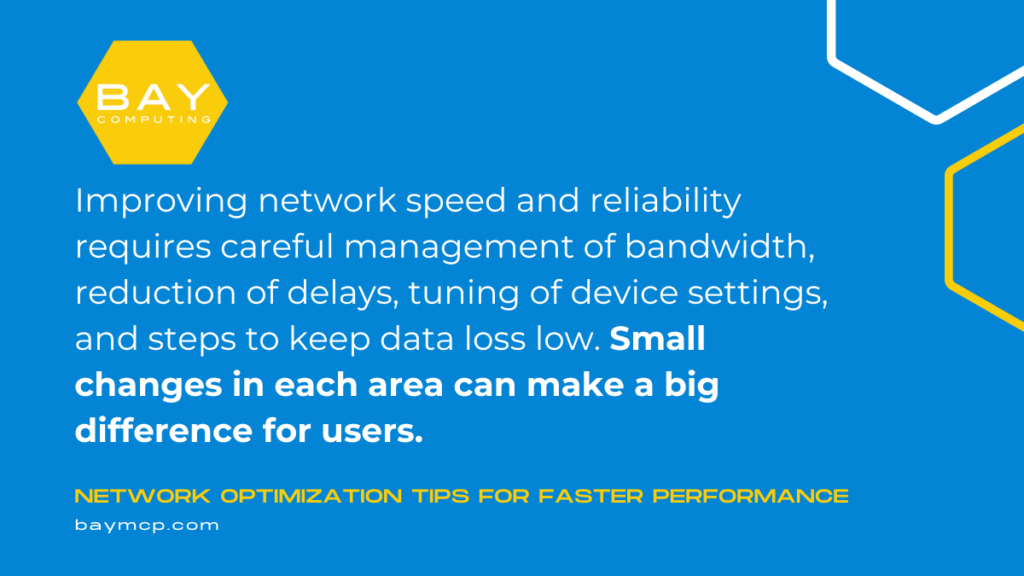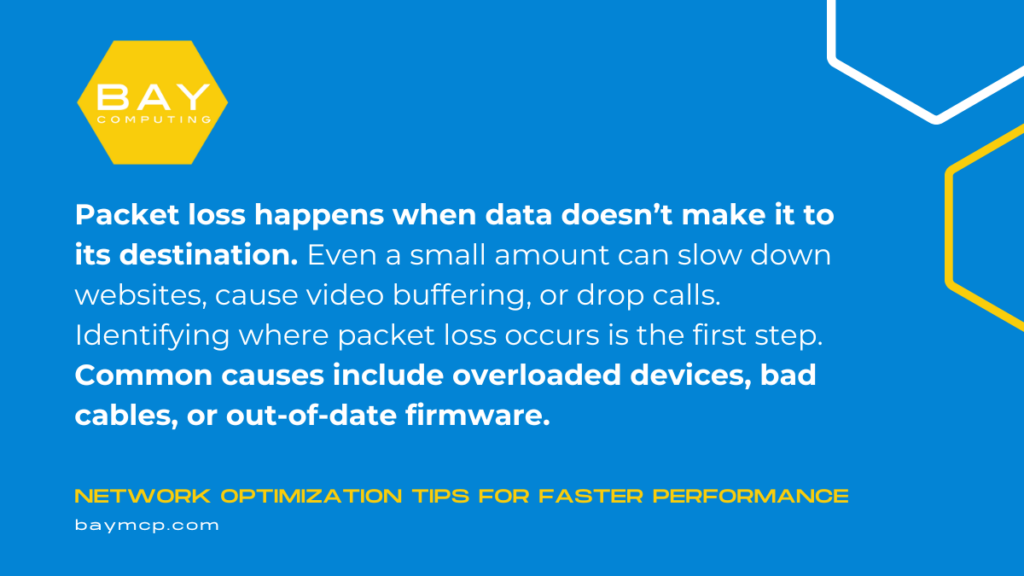Network Optimization Tips for Faster Performance
Fast and reliable network performance is essential for both businesses and individuals today. Slow connections can frustrate users, lower productivity, and make even simple online tasks feel difficult. Network optimization helps improve speed, reliability, and the overall experience for everyone on the network.
There are several practical ways to boost network performance, from monitoring usage and removing unnecessary traffic to using smart tools and settings. Simple steps like data compression, traffic shaping, and good infrastructure can lead to noticeable gains in speed and efficiency, as seen in strategies for network optimization.
Learning proven tips and methods can help anyone get the most from their network. Understanding these techniques makes it easier to spot problems and find solutions that make a real difference.
Core Strategies for Network Optimization

Improving network speed and reliability requires careful management of bandwidth, reduction of delays, tuning of device settings, and steps to keep data loss low. Small changes in each area can make a big difference for users.
Bandwidth Management Techniques
Bandwidth is the data-carrying capacity of a network. Allocating bandwidth wisely helps prevent congestion and keeps data flowing. Using Quality of Service (QoS), network traffic can be prioritized. For example, important applications like video calls can get higher priority while downloads run in the background.
Traffic shaping is a useful method. It delays or limits some data, like large file transfers, during peak times. This keeps the network from getting overloaded. Bandwidth monitoring tools let IT teams see which devices or programs use the most data.
Table: Common Bandwidth Management Tools
| Tool Type | Example Use |
|---|---|
| QoS Rules | Prioritize business calls |
| Traffic Shaping | Limit video streaming |
| Activity Monitoring | Flag unusual data spikes |
Managing bandwidth improves overall user experience and stops a single user from slowing down the whole network.
Reducing Network Latency

Latency is the delay it takes for data to move from one point to another. High latency can make applications slow or unresponsive. Shortening the distance data travels, such as using local servers or content delivery networks (CDNs), can help lower lag.
Removing unnecessary hops between devices also helps. Fewer switches, routers, or firewalls mean a faster path for data. Upgrading network cables and equipment to faster standards, like CAT6 or fiber, can cut down delays.
Real-time applications, like online gaming or video meetings, suffer the most from high latency. Checking and improving routes between key devices can lower ping times and packet travel. Most businesses keep an eye on latency with monitoring tools, so they can act quickly when response times start to creep up.
Optimizing Router and Switch Settings
Routers and switches run network traffic. If not set up correctly, they can be a hidden cause of sluggish performance. Firmware should always be up to date, as updates fix bugs and improve handling of data.
Key router and switch settings:
- Spanning Tree Protocol (STP): Stops loops in the network
- Port speeds: Match them to device needs
- VLANs: Group traffic for better security and quality
Proper configuration of routing protocols makes the network more efficient. For large networks, dynamic routing can adjust paths based on need. Also, disabling unused ports and services lowers attack risks and cuts wasted resources.
Regular reviews of settings ensure devices work their best. This is especially true as networks grow or change.
Minimizing Packet Loss

Packet loss happens when data doesn’t make it to its destination. Even a small amount can slow down websites, cause video buffering, or drop calls. Identifying where packet loss occurs is the first step. Common causes include overloaded devices, bad cables, or out-of-date firmware.
Testing network paths with tools like ping and traceroute can show where packets are being dropped. IT teams often replace aging hardware or fix wiring to solve the problem. Using Quality of Service (QoS) rules also helps, as essential traffic gets priority over less important data.
A table can help track trouble spots over time:
| Date | Device | Packet Loss (%) |
|---|---|---|
| 6/22/25 | Switch 1 | 2.5 |
| 6/22/25 | Router 2 | 0 |
Minimizing packet loss ensures smoother streaming, fewer dropped connections, and better user satisfaction.
Advanced Approaches for Sustained Performance
Ongoing network efficiency relies on deliberate strategies and tools. Techniques like prioritizing critical traffic, tracking network health, and using up-to-date hardware can prevent bottlenecks and maintain speed.
Implementing Quality of Service (QoS)
Quality of Service (QoS) assigns priority to different types of network traffic. This means important applications—for example, video calls or cloud backups—always get enough bandwidth, even during congestion. Network managers set rules to identify and rank this traffic.
Common QoS policies include reserving bandwidth for voice or video, rate-limiting file downloads, and marking traffic types with different priorities. These steps prevent lag and service degradation for applications that need consistent speeds.
QoS can be managed on routers and switches in most business networks. Configuring these settings needs careful planning. The network team should review usage patterns often to make sure rules still match current needs and prevent misuse of bandwidth.
Monitoring and Troubleshooting Tools

Monitoring tools let teams see real-time network performance and spot issues before they spread. Dashboards, alerts, and reports help track metrics such as latency, packet loss, and throughput.
Using centralized dashboards, network managers can get a single view of all devices and connections. They can set alerts to notify of unusual behavior like traffic spikes, slowdowns, or device failures.
Effective tools provide historical data, so patterns and recurring problems are easier to find. Audit logs also help diagnose complex issues.
Upgrading Network Hardware
Modern equipment is vital for supporting rising traffic and new technology. Old switches, routers, or cables can become bottlenecks that slow down entire networks.
Upgrading to higher-capacity hardware, such as gigabit or multi-gigabit switches, can dramatically boost throughput. Choosing switches with support for features like link aggregation and faster ports allows networks to scale with demand.
Replacing legacy devices also brings better support for security and advanced management options. Combined with faster cables—like replacing Cat5 with Cat6 or fiber—it is possible to improve speed and stability.
Ready to Maximize Your Network Performance?
Don’t let slow connections hold your business back. At Bay Computing, we specialize in comprehensive network management solutions designed to optimize speed, enhance reliability, and keep your systems running smoothly. Whether you need expert bandwidth management, latency reduction, hardware upgrades, or ongoing monitoring, our team is here to help.
Contact us today to discover how we can tailor a network optimization strategy that meets your unique needs and boosts your business productivity.




